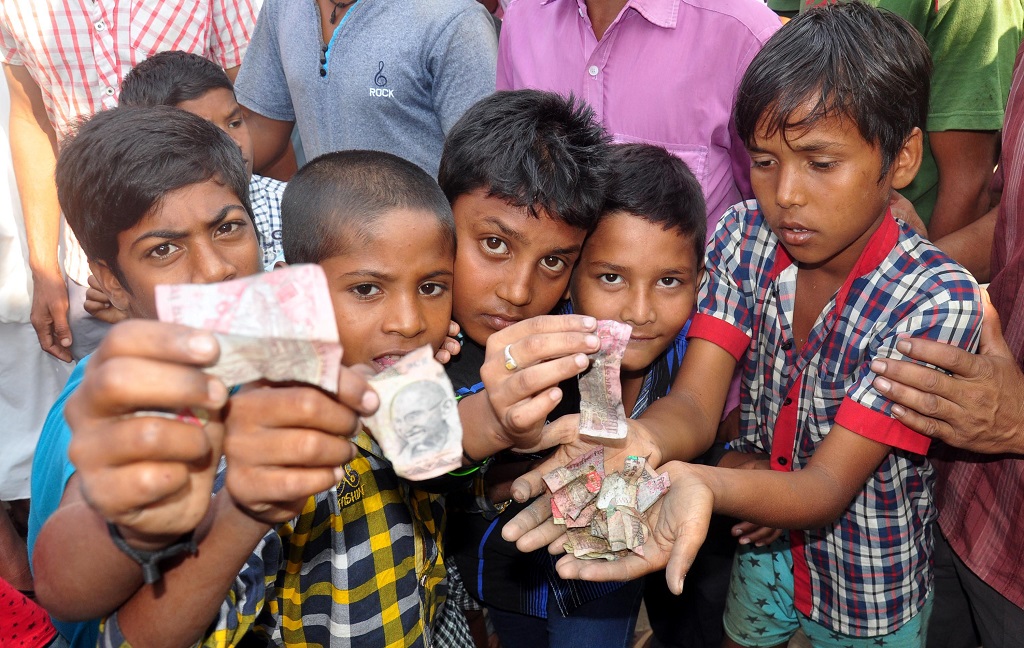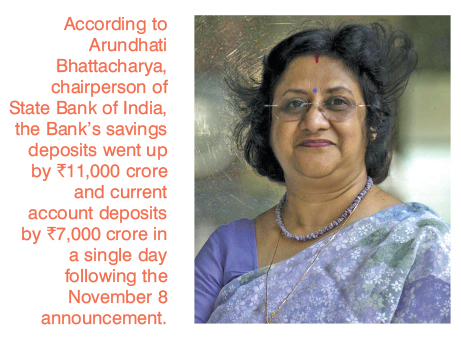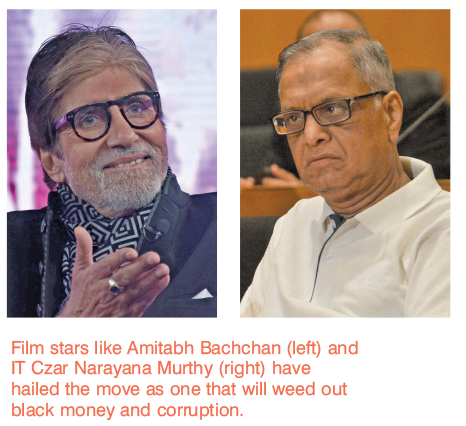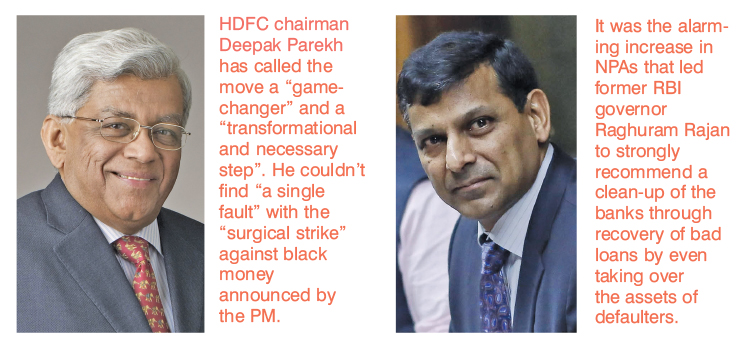
The past month has shown the travails caused by demonetization and the collateral damage it has left behind in all spheres of the economy. Have Modi’s achhe din truly eluded the common man?
By Ajith Pillai
It is often difficult to make sense of a government decision that comes without warning and is not followed by a convincing explanation. The recent demonetization drive by the Narendra Modi government falls into the classic “bolt out of the blue” event that has stumped the nation. As a result, providing a rationale for the largest cash culling operation in the world is difficult unless one quietly accepts the official thesis that it was a surgical strike against black money when, even by a generous estimate, no more than five percent of unaccounted wealth is in cash.
But was the government action that simplistic and singularly focused or were there several wheels within wheels behind the prime minister’s surprise announcement on November 8 that invalidated currency notes of Rs 500 and Rs 1,000 denominations? There are numerous theories about why such a decision was initiated which caused immense suffering to the common citizen. However, the entire process which delivered a veritable shock to the economy remains shrouded in secrecy.
ILL-CONCEIVED MOVE
For a start, it is not clear whether the move was well-thought-out. If it was, then the plan failed miserably as what was supposed to only inconvenience the public for a few days has stretched out for two weeks and threatens to persist for months. Normal banking operations have been crippled. Business at all levels has been impacted. Daily wage workers have been rendered jobless with employers unable to pay salaries. The entire farming community and the rural economy are severely distressed. In fact, the cash crunch has hit every rung of society.

At the last count, 60 people lost their lives. Some took the extreme step fearing that the money they had scrimped and saved for years and hidden in their homes would be lost forever. Senior citizens standing in serpentine queues outside banks and ATMs collapsed from exhaustion. Women with infants had to brave the elements to get their money. The number of man-hours lost to demonetization has not been computed but would be considerable.
Given the nationwide impact due to demonetization, many feel Modi has a lot to explain. Senior CPI leader and Rajya Sabha MP D Raja told India Legal: “Demonetization has triggered a national crisis and disrupted normal lives and the livelihood of the common man. This was supposed to be a fight against black money but now it seems like a war against the people.”
Fake news
Demonetization triggered many false stories in mainstream as well as social media. Some of them:
- Zee TV “broke” a story about nano chips in the new Rs 2,000 notes which would enable them to be located by a satellite even if they were hidden 120 feet under the ground. The news was denied by RBI.
- A Telugu channel took ownership of a story in social media about a Gujarati businessman surrendering Rs 6,000 crore of his black money in support of demonetization. He denied it.
- A Delhi-based Hindi TV channel showed a story of a tea stall in RK Puram accepting payments on Paytm. The glitch? The person interviewed was an employee of the channel! The story was withdrawn and an apology tendered.
So what does one make of the demonetization drive? Here are some insights of bureaucrats, bank officials, economists, opposition and BJP politicians and members of the larger Sangh Parivar. But all conclusions drawn are limited by the fact that the prime minister took the decision keeping even his cabinet and top bankers in the dark.
OFFICIAL SPIN
For the record, one is told that demonetization was to weed out unaccounted money. The BJP, led by the PM, has been hard-selling this as the primary objective of the move. The government claimed that it is a battle in which the common citizen has joined cause with the government to root out the evil. The sacrifices made by the aam janata towards the effort have been lauded and celebrated no end.
But all those who know anything about unaccounted wealth will tell you that that cash constitutes only a minuscule amount of black money in the economy. According to a study by the National Institute of Public Finance and Policy commissioned by the finance ministry in 2014, the black component of the economy is approximately Rs 90 lakh crore or 70 percent of the GDP. Of this, no more than Rs 2-3 lakh crore is in hard cash. So, how has demonetization weeded out black money?

According to a former finance ministry official: “The only objective demonetization has served in real terms is in neutralizing counterfeit currency which funds terrorist groups and accounts for about Rs 400 crore. But the real problem of black money has not been tackled. Cash culling has been projected as a fight against illegal wealth because it has popular appeal. I am sure the government had other reasons for going ahead with such a move.”
CORRUPT PRACTICES
The sub-text of what he said is that the war against black money should actually mean rooting out corrupt practices that help the accumulation of illegal wealth in the corporate world, in the bureaucracy, among political parties and in various arms of the government. It should involve closing in on offshore accounts, shady deals, suspect trading practices and under-reporting of profits. This black wealth cannot be found in gunny sacks or hidden in godowns.
According to a study by the National Institute of Public Finance and Policy commissioned by the finance ministry in 2014, the black component of the economy is approximately Rs 90 lakh crore or 70 percent of the GDP. Of this, no more than Rs 2-3 lakh crore is in hard cash.
But by pitching the demonetization drive as a Good Vs Evil fight, the BJP has confused many. Its spokespersons as well as Modi have been reiterating that those who oppose the government are with the evil forces behind black money. The party has been lucky to have its share of supporters from the Indian industry.
HDFC chairman Deepak Parekh, has called it a “game-changer” and a “transformational and necessary step”. He couldn’t find “a single fault” with the “surgical strike” against black money. IT Czar NR Narayana Murthy gave this endorsement: “I think it’s a good thing. It brings down black money, corruption….and in some form, it is an incentive for people to use the digital economy. So, on all the three dimensions it’s a good move. I think we should all be celebrating.” Film celebs—Amitabh Bachchan, Rajnikanth, Anushka Sharma, Anurag Kashyap and Madhur Bhandarkar among others have all hailed the move on social media.
Politically, the BJP hopes to trumpet that the defunct money that is not deposited in banks is the black money that has been disabled. A finance ministry source revealed: “The government obviously does not wish all the money in circulation to be returned. Only then can the unreturned money be projected as the black component which has been rendered unusable. This is why the rules relating to returning old notes have been constantly changing. It confuses ordinary folk. Many will be reluctant to return their money fearing prosecution. At the end of the day, the BJP hopes to tell the public that it has disabled a few lakh crores of unaccounted money. This will help it score a moral political victory.”
THE BIG BAILOUT
If the fight was not really an all-out war against black money, what was it? One view gaining ground in banking circles is that the surgical strike was necessitated by the urgent need to recapitalize and revive the banking system reeling under bad loans and a crisis precipitated by Non-Performing Assets (NPAs).
According to the RBI, as of June 2016, NPAs and bad loans added up to Rs 6.30 lakh crore. Of these, PSU banks accounted for Rs 5,71,443 crore and private banks, Rs 58,331 crore. This was a sharp increase from last year’s figures—Rs 2,85,748 crore for PSU banks and Rs 34,805 crore for private banks.
It was this alarming increase in NPAs that led former RBI governor Raghuram Rajan to strongly recommend a clean-up of the banks through recovery of bad loans by even taking over the assets of defaulters. Such a move would have involved stepping on the toes of many big corporate houses allegedly close to the ruling dispensation.
Post demonetization, the banks find themselves in a happy situation where they can consider delaying action against errant corporate houses and big business responsible for the NPAs. Or even gradually moving the bad loans to a special category called Advance Under Collection Account (AUCA) where loans that cannot be recovered are parked. Once this is done, the NPAs are no longer reflected in the balance sheet of the banks. A senior bank official told India Legal that the AUCA option can be now exercised because banks are suddenly flush with funds in the form of defunct Rs 500 and Rs 1,000 notes deposited by the public.
ADDITIONAL LIQUIDITY
The enhanced liquidity will reflect in the profitability of banks since they can exercise the option of investing part of the newly deposited monies in government bonds and earn interest. Additionally, rate cuts would mean they can give easy loans at low interest rates, further adding to their income while simultaneously saving money by cutting interests on deposits. “Ironically, the defunct money that the common citizen has returned to the banks will be what rescues the banks and not any black money,” said a bank official.

Writing off corporate loans is a practice followed by banks, although none of them will openly admit to this. When CPM general secretary Sitaram Yechury recently raised the issue of Rs 1,12,708 crore unpaid loans being written off between 2014 and 2016, he was reportedly informed by finance minister Arun Jaitley that there were no write-offs but “merely an accounting entry”. But in reality what happens is that once a loan is removed from the books, it loses its priority and is for all practical purposes forgotten.
Post demonetization, banks have suddenly grown green shoots with huge volumes of deposits. Its books suddenly reflect a healthy inflow of cash and liquidity. According to Arundhati Bhattacharya, chairperson of State Bank of India (SBI), the Bank’s savings deposits went up by Rs 11,000 crore and current account deposits by Rs 7,000 crore in a single day following the November 8 announcement.
The reason for this is that the notes suddenly declared defunct constituted 86 percent of all the currency in circulation. And it is this 86 per cent which is being sucked back into the banking system. By December 30, the government, according to its submission in the Supreme Court, expects Rs 10 lakh crore worth of the old notes to be returned to banks. But the Rs 500 and Rs 1,000 notes in circulation (before demonetization) is estimated to be Rs 16 lakh crore. So the big question is whether the RBI will print an additional Rs 6 lakh crore worth of notes to restore normalcy? If so, will this money also be used to write off corporate NPAs as alleged by Kapil Sibal, Congress spokesperson and lawyer? Sibal suspects this might be the case. “I get the sense that there is this thinking in the government that the money deposited by people in banks could be utilized to wipe out NPAs of corporates who have defrauded the country. In such a situation, the Rs 6 lakh crore may also come in handy.”
 Sibal’s observation came a day after a report surfaced in the DNA newspaper that SBI had written off Rs 7,016 crore owed to it by more than 60 of its 100 willful defaulters within a week after demonetization. The loans shifted to AUCA included the Rs 1,200 crore due from Vijay Mallya. But SBI has denied that the loans have been written off and maintains that they would be recovered in due course.
Sibal’s observation came a day after a report surfaced in the DNA newspaper that SBI had written off Rs 7,016 crore owed to it by more than 60 of its 100 willful defaulters within a week after demonetization. The loans shifted to AUCA included the Rs 1,200 crore due from Vijay Mallya. But SBI has denied that the loans have been written off and maintains that they would be recovered in due course.
It was no secret
Though the government projected the surgical strike on black money as a top secret operation, there was nothing secret about it. Many leading banks saw a sharp spike in deposits since September. This was unprecedented and is being linked to people who had been tipped off about the culling of high denomination notes. Similarly, gold sales shot up days before the PM’s announcement. It is also alleged that the BJP knew what was coming and had quickly deposited its money into banks.
But those who read newspapers already had an advance warning. On October 21, The Hindu’s Businessline made it clear that banknotes “of the denomination of Rs 2,000 will be in circulation soon”. It said that the new notes had already been printed, and their dispatch from the currency printing press in Mysuru had commenced. It further pointed out that the “move assumes significance in the wake of a demand from some quarters that notes of Rs 1,000 and Rs 500 denominations be withdrawn to prevent hoarding of black money”.
Similar stories appeared earlier in some Gujarati and Hindi dailies. If the media knew about demonetization, what was so secret about the surgical strike? It is safe to assume that businessmen and politicians who followed the media or had access to the government would have also known.
BANKS IN A MESS
That banks needed an infusion of funds to be rescued was evident for quite some time now. According to an IMF report in May quoted in The Wall Street Journal, the “Tier-1 capital” or money set aside by Indian banks to tide over a financial crisis, was the lowest among major economies in the Asia-Pacific region. It said that NPAs and bad loans amount to 7 percent of the national GDP and translates into a mind-boggling $146 billion.

To save PSU banks, the government even launched the Indradhanush scheme in August 2015. Under it, 13 banks were to be given Rs 20,058 crore. But it failed to have any impact as the NPAs kept growing. Thus came the demonetization project. But if the government had openly admitted the real reason, it would have sent jitters through the financial world and driven away big depositors. So demonetization was conveniently declared as a surgical strike against black money.
But the fight against black money goes beyond demonetizing. Dr EAS Sarma, a former secretary in the Union finance ministry with impeccable credentials wrote to Modi on November 12 urging him to take the fight forward and catch the real culprits. To quote from his letter: “One source of corruption that has become rampant these days is the political patronage involved in PSU banks dispensing credit to corporates without exercising due diligence. One glaring example of this was the manner in which State Bank of India had flippantly signed an MoU in your presence in Australia to grant a billion dollar loan to the Adani group, without carrying out any due diligence. Under public pressure, SBI had to withdraw from that MoU but it is public knowledge how these PSU banks have misused the so-called ‘Capital Debt Restructuring’ scheme and other versions of that scheme to expose public funds to the risk of becoming NPAs. There are conflict-of-interest situations between RBI and the PSU banks, and the finance ministry and the PSU banks which need to be removed and PSU bank reforms undertaken urgently.”
The names of those granted favors by the banks are well-known and their bad loans run into thousands of crores. They reside and function in the country with impunity. They should perhaps have been asked to pay up as a first step.
THE DOWNSIDE
Many have been hit by the government’s surgical strike. Varun Berry, MD, Britannia Industries, sees a 30-70 percent drop in the sales of various FMCG products. Pawan Munjal of Hero MotoCorp has said that footfalls at dealers of Hero motorcycles have fallen by as much as 50 percent in November. According to the Confederation of All India Traders, trade in markets across the country is down by 25 percent post demonetization. At Azadpur mandi, the wholesale vegetables and fruits market which supplies to the Delhi region, daily trade volumes have reduced by over 50 percent.
 Saktiman Ghosh, general secretary of the National Hawkers Association, spelt out the woes of small and marginal traders to India Legal: “The government should not have imposed an economic emergency and derailed the lives of millions. The retail sector has been virtually paralyzed. The informal economy employs roughly 93 percent of India’s working class. It is now impoverished. The entire economy has been hit and will take a long time to recover.”
Saktiman Ghosh, general secretary of the National Hawkers Association, spelt out the woes of small and marginal traders to India Legal: “The government should not have imposed an economic emergency and derailed the lives of millions. The retail sector has been virtually paralyzed. The informal economy employs roughly 93 percent of India’s working class. It is now impoverished. The entire economy has been hit and will take a long time to recover.”
According to trade analysts, one of the after-effects of the artificially created cash shortage will be the tendency of consumers to only spend on essentials. This will see a sharp decline in demand for luxury goods. Once such a mindset sets in, it takes time for it to change. This is perhaps why Kaushik Basu, World Bank chief economist and former chief economic advisor feels that demonetization is not “good economics” and “the collateral damage is likely to far outstrip the benefits”.

But will the economy boom with banks giving out easy loans? The off-take of loans from banks this year has been very poor and is not likely to revive now. One prediction by Ambit Capital even puts the GDP growth this fiscal at 3.5 percent—down from 7.5 percent last year. Given this scenario, banks would have to go in for risky loans which could only add to its NPAs.
 So what will be Modi’s next step? No one in the BJP knows his mind. But one buzz doing the rounds is that he may even transfer part of the defunct money deposited in the banks into Jan Dhan accounts. There is no confirmation of this, although WhatsApp messages (often suspect) would have us believe that it has been decided to allocate anywhere between Rs 10,000 and Rs 50,000 to each Jan Dhan account holder. If that is indeed true, then it will be the first case of robbing Peter to pay Peter!
So what will be Modi’s next step? No one in the BJP knows his mind. But one buzz doing the rounds is that he may even transfer part of the defunct money deposited in the banks into Jan Dhan accounts. There is no confirmation of this, although WhatsApp messages (often suspect) would have us believe that it has been decided to allocate anywhere between Rs 10,000 and Rs 50,000 to each Jan Dhan account holder. If that is indeed true, then it will be the first case of robbing Peter to pay Peter!
Lead Picture: A security guard trying to close the door against people queuing outside a bank in Kolkata. Photo: UNI

